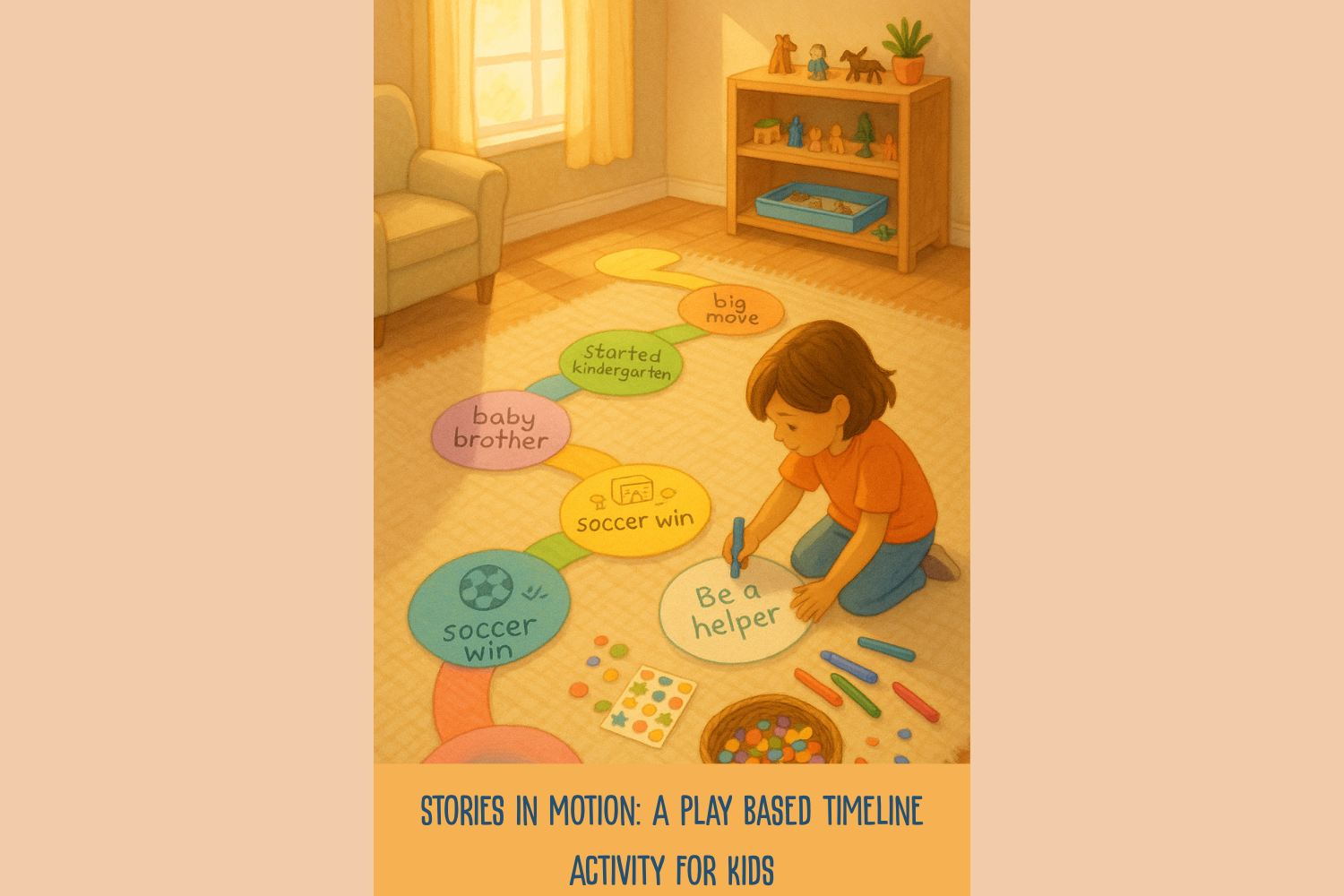Stories in Motion: A Play-Based Timeline Activity for Kids
* Blog may contain some affiliate links. That means I may earn a small commission (at no extra cost to you) if you choose to buy through them. I only share items I love, trust, or would absolutely use in my own play spaces. Your support helps me keep Playful Horizons running and growing—thank you!
The Power of Movement + Meaningful Memories
Kids don't just tell their stories—they move through them, jump into them, and sometimes even wiggle and roll right through the tough parts. Stories in Motion transforms a regular timeline reflection into a fully immersive play experience, helping children map out their past and imagine their future.
Designed for play therapists, school counselors, and child-focused clinicians, this activity pulls together gross motor skills, imaginative play, and therapeutic reflection to support children in understanding the past experiences that have shaped them and reflect on their future goals.
Why It Works
This activity bridges movement, creativity, and memory to support:
Self-awareness through embodied storytelling
Goal-setting with emotional intention
Gross motor integration for sensory engagement
Language development through narrative expression
Play-based processing of life events and transitions
It’s flexible, fun, and adaptable to individual sessions, group work, or even classroom SEL.
Supplies You’ll Need
Colorful stepping stones (foam, felt, paper cutouts, or yoga mats) - these pre-cut circles are a great option!
Various materials for play (puppets, miniatures, or art supplies)
Optional:
Printable “Stories in Motion” take home timeline - BUY HERE
Real stepping stones (like these) to add a fun physical component
Music or a sound machine for ambiance (THIS one allows you to play both!)
Activity Steps
1. Create the Story Path (Past)
Lay out 6–8 stepping stones in a curve or zigzag. Each stone represents an important chapter in the child’s life. Instead of labeling with months or years, ask things like:
“What are some big things that have happened in your story?”
“If your life were a movie, what scenes would be in it?”
As they walk or hop to each stone, invite them to draw, write, or use stickers to represent the memory. Encourage the use of play materials such as puppets to act out the scene or miniatures to represent what happened.
2. Add Sound & Movement Play
Make the experience engaging and multi-sensory:
Add music that reflects their mood while walking the path
Let them choose an animal movement or action to act out each memory (tiptoe for quiet memories, stomps for angry ones, spins for surprises)
Use a puppet guide or “timeline tour guide” to lead them through
Use sensory stones next to the paper stones to create an obstacle coarse like path for the child to walk through
3. Spot the Strengths
Pause at each step to reflect. Use “I wonder” statements to give the child control and encourage self-reflection.
“I wonder what helped you get through this.”
“I wonder who was there for you?”
“I wonder what you learned about yourself?”
They can add mini-symbols for their strengths: a heart for love, a star for bravery, a hand for helpers, etc. You can have them draw these, cut out pictures from a magazine, place a sticker, or select a miniature.
4. Build the Future Path
Now shift direction—literally! Create 4–6 blank stepping stones leading forward. These are “future steps.” Encourage the child to dream, hope, and wonder:
“What would you like to try someday?”
“What kind of person do you want to be?”
“What’s something little that could make a big difference?”
Let them draw or act out each future goal. If they want, they can even name each step like a chapter title: “The Brave Me” or “Kindness Power”
5. Storytime Showdown (Optional Group Version)
In group settings, turn the timeline into a mini theater! Each child walks their path while narrating (or using a puppet) to share key moments and goals. Others can cheer them on, celebrate their strengths, or even offer positive encouragement on sticky notes.
6. Wrap Up and Reflect
End with a celebration walk—music, claps, or a simple “high five path.” Then sit together and reflect:
“What parts of your story are you most proud of?”
“What parts of your story still feel hard?
“Which step are you most excited about?”
“What do you want to remember about this journey?”
Bonus: Use the “Stories in Motion” printable (found HERE) to let them take home their timeline home with them!
Therapist Tips
Use this activity at the start of therapy to build rapport, for gather background information and set goals during intake, or during transition sessions to support closure.
For children with trauma histories, offer co-regulation throughout and adjust the pace as needed.
For younger children or those with limited verbal skills, emphasize drawing, symbols, and roleplay.
